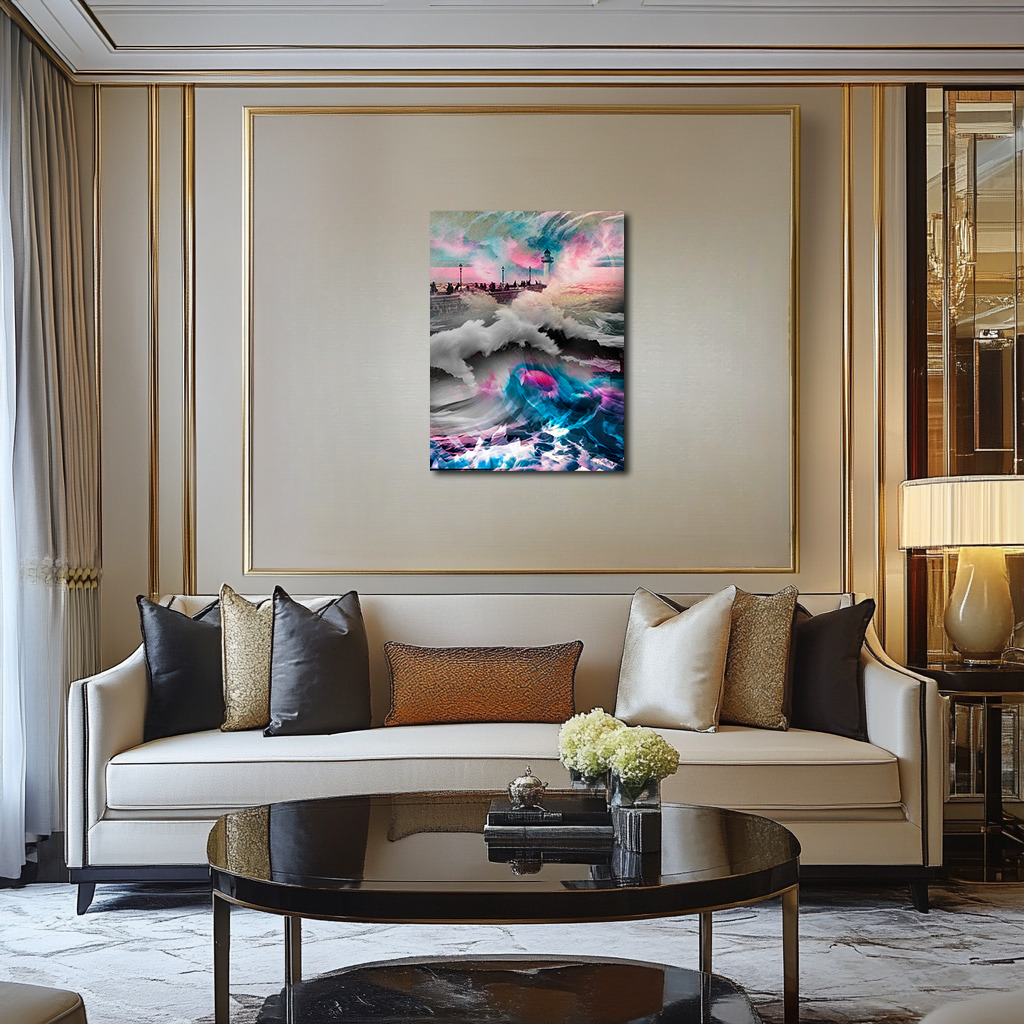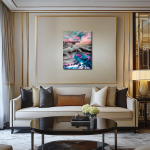Threshold of Tides: The Jetty at Le Havre Reimagined in Collision and Color
Threshold of Tides: The Jetty at Le Havre Reimagined in Collision and Color transforms Monet’s 1860s vision into a vibrant expressionist collage of rising waves, dissolving boundaries, and emotional force. A storm of pink, cyan, and violet light sweeps through the seascape, blurring jetty and sky into a luminous meditation on surrender, motion, and the fragile resilience of presence. This piece reimagines Monet’s marine vision not as calm reflection, but as a spiritual immersion into the elemental, where the self is both the watcher and the wave.
Please see Below for Details…
Hotline Order:
Mon - Fri: 07AM - 06PM
404-872-4663
Claude Monet’s The Jetty at Le Havre , completed in the 1860s, stands as an early expression of his deep fascination with marine life and movement—the constant dialogue between human construction and the ever-changing face of the sea. His depiction of the jetty, steady and narrow, pushing into the surf with lanterns flickering above, was not just a view—it was a metaphor for presence amid vastness. In this conceptual reinterpretation, titled Threshold of Tides: The Jetty at Le Havre Reimagined in Collision and Color , the structure remains but is submerged in a storm of sensory transformation. The sea does not stay at the edge—it rises, swirls, folds, and floods the entire space with expressionistic rhythm, transforming Monet’s serene observation into a spectacle of elemental force.
The composition opens with a wave that refuses containment. It does not roll gently toward the rocks—it rises, cracking against the jetty like a choir of motion. Spray bursts into the sky, dwarfing the human silhouettes standing along the pier. The figures, once still observers, are now momentary shadows framed against nature’s breath. The lighthouse remains—a slender column of purpose. Its light is faint, but it does not waver. Around it, waves curl, both in pigment and in digital form, creating a vortex where time, perception, and atmosphere churn together without boundary.
The ocean is no longer just a background subject. It becomes the protagonist. It stretches through every layer of the image, shifting from greyscale realism to abstraction to dream. At the base, the waves take on surreal hues—pinks, magentas, cyan, and deep violet—all blooming in soft crests and whirlpools of fluid energy. These are not naturalistic colors. They are emotional truths rendered in visual rhythm. The water does not only move. It feels. It remembers. It speaks in hue and pulse.
Between these layers, we witness the transformation of medium itself. What begins as oil-painted sea turns into ink-drenched digital folds. The brushstrokes of Monet dissolve into photographic textures, then dissolve again into translucent ribbons. This constant shifting mirrors the sea itself, always changing, always arriving, always slipping beyond frame.
The jetty, normally a solid, guiding form, is split by composition. It appears both fixed and dissolving, its edges blurred by mist and water, as if being reclaimed by the very force it once sought to divide. The people walking upon it are no longer individuals—they are part of the tide, silhouettes swallowed by spray, leaning into wind, fragile but luminous. Their presence is ephemeral, poetic, grounded only in contrast to the sea’s expanding language.
Sky and sea merge in a pastel halo—sunlight filtered through clouds that scatter like torn pages. This is no longer the factual sky of Normandy. It is a dreamt horizon, one that breathes in the memory of light rather than its reflection. At the point where sea and air embrace, the lighthouse stands like a whisper of stillness, a vertical note in a symphony of horizontal collapse.
Color theory becomes a compass here. The top portion of the image is awash in pale rose and lavender, speaking to nostalgia and transcendence. The middle churns in whites and greys—emotive neutrality, charged tension. The lower portion dives into deep chromatic emotion—cerulean, plum, fuchsia—each wave layered with translucent digital echoes, like music playing across the foam. These are not decorative. They are the soul of the piece. They represent the unseen emotions under the surface—the undertow of memory, the swell of feeling that cannot be spoken.
As the artist, I approached this reinterpretation as a meditation on what it means to stand still while everything moves. Monet painted the jetty as a moment of calm observation. I wanted to paint it as a threshold of surrender—a space where you meet the unknown and watch yourself dissolve into it. The jetty is no longer a place to witness the sea. It is a place to become it.
The lighthouse’s light is not strong, but it endures. That small resilience becomes everything. The people on the pier may vanish into mist, but the memory of their silhouette remains. The ocean may crash and roar and swirl in impossible color, but at its core is rhythm, pulse, grace.
Threshold of Tides is not only about Monet’s Le Havre. It is about all moments where we find ourselves between force and fragility, structure and release. It is about remembering that sometimes, to know the ocean, we must let it rise through us.
Add your review
Your email address will not be published. Required fields are marked *
Please login to write review!
Looks like there are no reviews yet.








